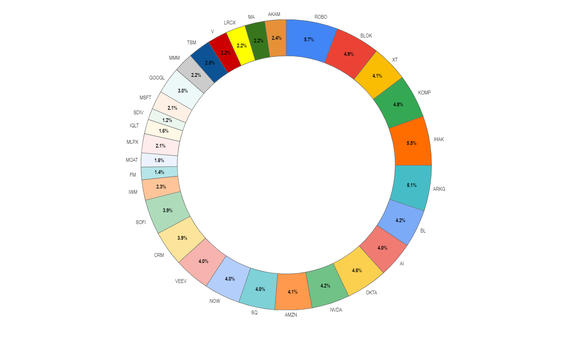There's almost too much information about the stock market out there. It can be confusing to know where to start. There's no one-size-fits-all investing plan, but there's a general outline you can follow for success. You need to define what you're hoping to accomplish, come up with a strategy to meet those goals, and find the best investments to execute that strategy. My own approach might not be perfect for you, but it might give you some helpful ideas.
First things first
Before diving into the stock market, I have to lay the foundation. I would make sure all my bases are covered in my financial plan so that I can responsibly invest for growth. I want a cash buffer to cover unexpected expenses or cash flow interruptions. I also need the right insurance in place to protect me and my family from catastrophic losses.
Each piece of this financial plan serves a specific purpose, and I want to set the pieces up in a balanced way to maximize each one's value. My invested capital's only role is to generate returns. The $5,000 that we allocate here is purely to achieve those returns. That's the context that this strategy is built on.

Image source: Getty Images.
My risk tolerance and objectives
Everyone has a different set of goals and risk tolerance, and those determine how you should invest. Stocks are volatile, but they provide reliable long-term growth. I only invest capital that I don't intend to touch for years, and I need to be completely comfortable experiencing temporary losses when bear markets inevitably hit.
This means that my time horizon is long, and my risk tolerance is relatively high. I'm confident that I won't panic or get too greedy as the market cycle progresses, because I've now lived through several crashes, and I've dedicated time to learning about portfolio theory. Once I've built my financial safety net, the first $5,000 that I invest is going specifically toward long-term growth.
If you have lower risk tolerance or a shorter time horizon, my strategy won't be the right one for you. A risk tolerance questionnaire is a good place to start if you aren't sure about your own situation.
Target allocation
It's important to find the right balance between diversification and targeted investments. Diversification reduces risk, but it also dilutes the positive impact of your winners. I'm confident in a few economic and business themes that will define the coming decades. In those cases, I like ETFs that allow me to invest in the whole industry, rather than an individual stock. Even when I have high conviction about an individual company, I have to recognize my own limitations. It's impossible to be 100% certain about the future for any single company.
Still, there are characteristics that make some stocks perfectly suited to my strategy. It's important to own individual stocks to maximize your opportunities for growth. It takes a lot more work to identify and monitor these individual companies, but that's a commitment I'm comfortable making.
By combining ETFs and individual equities, I'm confident that I can outpace the market over the long term without taking on too much risk. Finally, I also want to ensure that I invest in a few different categories. Owning a bunch of stocks that are highly correlated partially defeats the purpose of buying individual stocks, and it also reduces the benefit of diversification. If I'm not going to time markets, then I should put myself in position to succeed across different cycles.
My portfolio would be composed of:
- 40% individual growth stocks
- 30% niche growth ETFs
- 20% alternative or value stocks
- 10% value or alternative ETFs
My first investments would build a base of ETFs that focus on disruptive growth and global megatrends and would include:
- The Global Robotics and Automation Index ETF (ROBO 1.99%)
- Amplify Transformational Data Sharing ETF (BLOK 2.36%)
- iShares Exponential Technologies ETF (XT 1.36%)
- SPDR S&P Kensho New Economies Composite ETF (KOMP 1.82%)
- iShares Cybersecurity and Tech ETF (IHAK 0.93%)
- ARK Genomic Revolution ETF (ARKG 1.69%)
- iShares MSCI Frontier 100 Index Fund (FM +0.00%)
I would also sprinkle in some ETFs to add diversification and unlock returns when growth stocks are out of favor. These investments would include:
- iShares Russell 2000 Index (IWM 1.06%)
- Market Vectors Morningstar Wide Moat Research ETF (MOAT 0.62%)
- Global X MLP & Energy Infrastructure ETF (MLPX +0.74%)
- iShares Edge MSCI Intl Quality Factor ETF (IQLT 0.85%)
- Global X SuperDividend ETF (SDIV +0.33%)
With this foundation in place, I would purchase a handful of high-conviction stocks that provide either high growth potential or reliable dividend income. I like to buy stocks that have wide economic moats, strong cash flow, and sales growth that's outpacing the market. I also consider high-quality, financially healthy companies with attractive valuations. These investments would include:
- BlackLine (BL +0.04%)
- C3.ai (AI 3.04%)
- Okta (OKTA 2.41%)
- Nvidia (NVDA 3.78%)
- Amazon (AMZN 0.60%)
- Microsoft (MSFT +0.02%)
- Alphabet (GOOGL 3.21%)
- Square (SQ 1.21%)
- ServiceNow (NOW +0.16%)
- Veeva Systems (VEEV 1.63%)
- Salesforce.com (CRM +1.27%)
- SoFi Technologies (SOFI 5.06%)
- 3M (MMM 0.63%)
- Taiwan Semiconductor (TSM 3.45%)
- Visa (V 0.20%)
- Mastercard (MA 0.21%)
- Lam Research (LRCX 5.08%)
- Akamai Technologies (AKAM 0.27%)
The resulting portfolio looks like this:

Image source: Author.
This portfolio has a little bit of everything -- but it's definitely skewed toward technology and growth. My portfolio will be more volatile than index funds, but I'm not worried about volatility due to my long time horizon. Adapting this process to your own personal goals could set you up for success.
